Previous: Maine Print Project (17)
Sensorium
Post #913 • November 28, 2006, 11:27 AM • 7 Comments
Cambridge, MA — "The art in Sensorium captures the aesthetic attitude of this hybrid moment when modernist segmentation of the senses is giving way to dramatic multi-sensory mixes or transpositions," sayeth the copy for the exhibition currently up at MIT List. It's a telling sentence, if not a melodious one. MIT is working on some of the world's most intractable problems. I'll wager that the List is the only entity on campus that specializes in problems that don't really exist.
It is difficult to take brute matter and make it convey feeling, and high technology seems only to complicate the options of how one might do so. With new materials, the artist now has more weapons than ever to aim at his foot. "Sensorium: Embodied Experience, Technology, and Contemporary Art" should have made an aesthetic case for sound, scent, and digitally altered perception in the visual arts arena. It failed, and reading the sentence quoted above clarified why: the modernist impulse to distinguish boundaries between media and make the essentials of each operate with maximum effectiveness is a highly effective strategy, and opposing it willy-nilly is not. Progress is not merely an Oedipal project. Cries of "Things are different now!" neglect the fact that in many important ways they're not.
On a more basic level, if I go to see a techie art show, the stuff has to work. A headset that should have put other people's views of Mathieu Briand's recreation of the control bridge from 2001: A Space Odyssey in front of my eyes, due to glitches, did not. Secondly, if my participation is required, doing so shouldn't force me to override my better judgment. A sound and light installation by Ryoji Ikeda described by the wall label as "a test of the participant's endurance"? Transluscent appliques impregnated with human sweat, by Sissel Tolaas, in what amounted to a bunch of giant BO-scented Scratch-n-Sniffs? Thanks, I'll let somebody else go first.
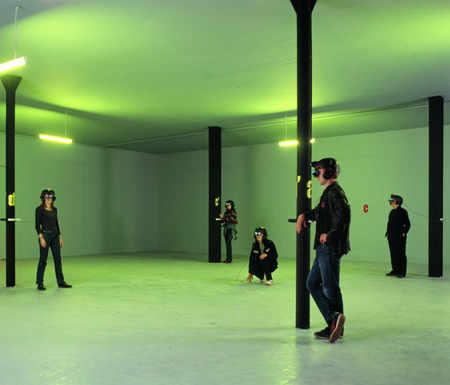
Mathieu Briand, SYS*017.ReR*06/PiG~EqN/5*8, 2001, installation view, Ateliers d'artistes de la ville, Marseille, France Photo by Denis Prisset, courtesy the artist
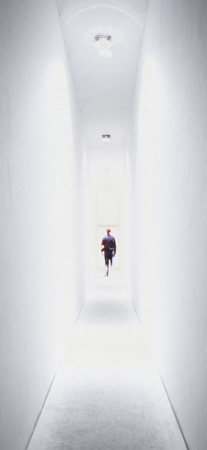
Ryoji Ikeda, spectra II, 2002, architectural audio-visual installation with strobe lights, laser, and 5-channel sound. Produced by forma. Photo by Robin Reynders, courtesy the artist
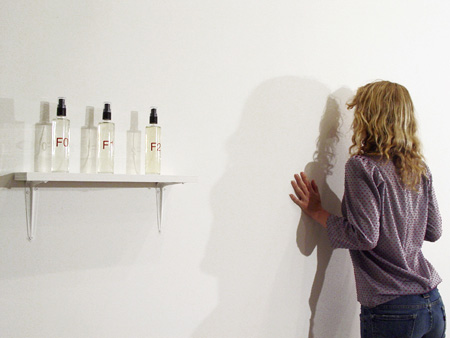
Sissel Tolaas, Fear I, 2005, synthesized human sweat pheromones micro-encapsulated and embedded in white paint on gallery walls, installation view, Roebling Hall, New York. Research supported by IFF Inc. Photo by Elizabeth Beer, courtesy the artist
Thirdly, I have shit to do, and I'm only going to wait so long for a video to get its act together. Bruce Nauman's lofty reputation does not justify my watching his 51-minute video of an infrared camera trained on his empty studio at night. That's just stupid. (He calls it Office Edit I, 11/11/00, 11/09/00, 11/16/00, 11/19/00, Mapping the Studio (Fat Chance John Cage), in a bald and pathetic attempt to glue profundity onto the work via the title.) In a small solo exhibition next door, Alix Pearlstein recorded videos of people engaged in strange tasks in minimalist environments, and they came off as failed improv exercises. It's vacuous to say that video art is just bad film, but examples like these bring that criticism to mind.
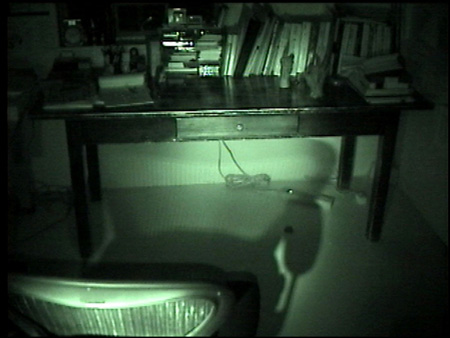
Bruce Nauman, Office Edit I, 11/11/00, 11/9/00, 11/16/00, 11/19/00, Mapping the Studio (Fat Chance John Cage), 2001, still from a DVD, 51:44 minutes, edition of 6. Courtesy Donald Young Gallery, Chicago © 2006 Bruce Nauman/Artists Rights Society (ARS), New York, NY
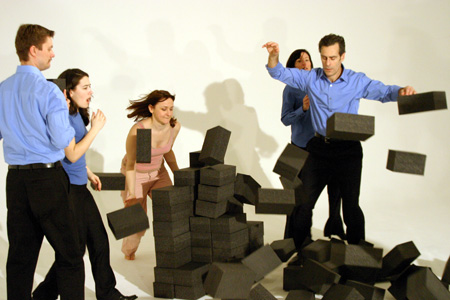
Alix Pearlstein, still from Crash, 2006
That leaves one successful piece. Opera for a Small Room by Janet Cardiff and George Bures Miller consisted of a built environment within a windowed room, stuffed with dusty bric-a-brac, old furniture, records, and turntables and lights that creepily turned themselves off and on. A voiceover related an inchoate story about a relationship as an orchestral performance and old songs wandered in and out of the auditory background. The technology, which must have been considerable, lay hidden, subordinated to the desolate effect. It evoked Tom Waits and Ed Kienholz, and although I wouldn't say it exceeded either of them, the work at least had some emotional bang. The rest of the show could have used some. Without it, this hybrid moment is not worth highlighting.
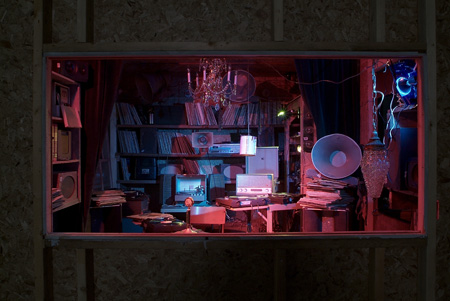
Janet Cardiff and George Bures Miller, Opera for a Small Room, 2005, mixed media installation (8 x 9 x 14 ft.) with synchronized lighting and sound ("Roadkill Crow Song," 20 minutes: composition/voice George Bures Miller; guitar, drums, mixing Titus Maderlechner; bass guitar, organ, orchestration Tilman Ritter). Fabrication assistance by Kyle Miller and Carlo Crovato. Courtesy the artists, Galerie Barbara Weiss, Berlin, and Luhring Augustine Gallery, New York. © Kunsthaus Bregenz, Austria. Photo by Markus Tretter
2.
November 28, 2006, 3:57 PM
This sounds like techie "mystification" to me. I remember a evolkative exhibition there (MIT) by Micheal Joo that better reflects the following quote; "The art in Sensorium captures the aesthetic attitude of this hybrid moment when modernist segmentation of the senses is giving way to dramatic multi-sensory mixes or transpositions," . His use of video, sculpture, ( which included manufactured blocks of salt ) and painting was imbued with a coherent, contemporary and yet socially pertainent statement ( however ambiguous ) about the relationships between technology and nature.
This current show seems more like a showcase - however I always laugh at Bruce Naumans video of how to put a pole in the ground.
3.
November 28, 2006, 6:27 PM
While checking for remarks, I realized that I should have put an 'an' instead of an 'a' in the previous comment. Sorry folks.
4.
November 28, 2006, 7:22 PM
Sadly, and predictably enough, this sort of thing is reminiscent of the profoundly stupid and ultimately suicidal path pursued by "serious" or art music, which has become a pitiful exercise in futility. The "enlightened" ones who cling to the thundering fiasco of that enterprise are like demented members of some sect that simply will not entertain reason or sense. Hence, they've been reduced to utter irrelevance outside their very limited confines. It's like some sort of autism. Thanks, but no, thanks.
5.
November 29, 2006, 3:19 AM
What is strange to me is that art makers are making pictures with a lot of animal content. I have zoo drawings from 1975 in my personal collection and have put them in contextual paintings as metaphorical subjects for a few years. My Grand-Papi had a friend at the zoo and they both taught me about anatomy and personality regarding primates and everything capable of communicative interaction. Now some people are making some trendy art that is based upon things which are intrinsic to me. Since they have some more money than me they will make a difference for the greedy art market people. But they will never understand the "bigger picture" as long as they are getting some.
6.
November 29, 2006, 3:34 AM
I dare say "animals" as Tilly was my best friend. He is a spider monkey. CoMo was an orangutan friend.
7.
November 29, 2006, 9:48 AM
I could not agree more - the show seemed like a real reach intellectually and just fails miserably.
1.
opie
November 28, 2006, 12:00 PM
If only you were writing for the NY Times...